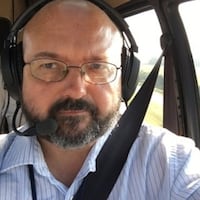“Let’s drive the fight,” he added.
Cain won’t have a far move, geographically speaking. AFRL is headquartered at Wright-Patterson Air Force Base, and his most recent role was director for air, space and cyberspace operations at the headquarters of Air Force Materiel Command, also based at Wright-Patterson.
Essentially, Cain is moving from Wright-Patt’s Area A to its Area B, taking the helm of a laboratory with more than 11,000 military and civilian employees found in 10 states and six countries, leading a science and technology enterprise valued at $3 billion, exploring and refining everything from lasers to autonomous combat aircraft to artificial intelligence and much more.
“We’re already in the community, but we’re very much looking forward to working with the community and taking care of the great AFRL workforce,” Cain said. “First thing on the list is to engage with that workforce. That’s my No. 1 priority.”
The outgoing commander, Maj. Gen. Heather Pringle, thanked family, colleagues and friends in an at times emotional farewell. Her official retirement after a 32-year Air Force career was part of Monday’s ceremony. She has accepted a job as chief executive of the Colorado-based Space Foundation, a nonprofit organization offering information, education and collaboration for what it calls the “global space ecosystem.”
Calling AFRL “America’s science and technology powerhouse,” Pringle told Cain she was “more than confident this team will make you proud every single day.”
Pringle took command of AFRL in June 2020 in a time of rapid change, barely three months after the COVID-19 pandemic took hold in the United States and about six months after a former commander, then-Maj. Gen. William Cooley, was removed from his post for allegations of misconduct. (Cooley recently retired after the Air Force reduced his rank by two levels, a year after his conviction at Wright-Patterson of abusive sexual contact.)
Gen. Duke Richardson, AFMC commander, praised Pringle for navigating the pandemic and putting AFRL to work for a new military branch, Space Force, while keeping the laboratory on task. She mastered “a lot of change, a lot of things outside her control that she had to figure out,” Richardson said.
“I don’t know that I’ve every seen you not in a upbeat mood,” Richardson told Pringle. “It’s very, very infectious. So somebody had the great idea to make her the lab commander.”
Cain received his commission from the Air Force Academy in 1995. He will lead AFRL’s technology and functional directorates, AFWERX and the 711th Human Performance Wing, among other AFRL teams.
He agreed that the future of the Air Force is being shaped at Wright-Patterson, home to Air Force research and logistics efforts.
“That is what we do,” Cain said. “Our mission is to discover, it’s to develop and it’s to transition technology at an incredibly important time for that mission, particularly with our strategic competition and our pacing challenge, China.”
President Biden nominated Cain for appointment to the grade of major general, the Department of Defense said in March.
About the Author



